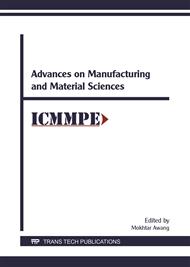[1]
C. Hsu and K. Lin, A study on microstructure and toughness of copper alloyed and austempered ductile irons, Mater. Sci. Eng. A, vol. 528, no. 18, p.5706–5712, (2011).
DOI: 10.1016/j.msea.2011.04.035
Google Scholar
[2]
S. F. Fischer, S. Muschna, A. Bührig-polaczek, and M. Bünck, Materials Science & Engineering A In-situ surface hardening of cast iron by surface layer metallurgy, Mater. Sci. Eng. A, vol. 615, p.61–69, (2014).
DOI: 10.1016/j.msea.2014.07.062
Google Scholar
[3]
B. Abdullah, S. K. Alias, A. Jaffar, N. H. Saad, M. F. Idham, and A. Ramli, XRD Evidence for Phase Structures of Niobium Alloyed Austempered Ductile Iron, vol. 458, p.431–434, (2012).
DOI: 10.4028/scientific5/amr.457-458.431
Google Scholar
[4]
P. H. S. Cardoso, C. L. Israel, and T. R. Strohaecker, Abrasive wear in Austempered Ductile Irons : A comparison with white cast irons, Wear, vol. 313, no. 1–2, p.29–33, (2014).
DOI: 10.1016/j.wear.2014.02.009
Google Scholar
[5]
C. Li, B. Shen, G. Li, and C. Yang, Surface & Coatings Technology Effect of boronizing temperature and time on microstructure and abrasion wear resistance of Cr12Mn2V2 high chromium cast iron, vol. 202, p.5882–5886, (2008).
DOI: 10.1016/j.surfcoat.2008.06.170
Google Scholar
[6]
C. Hsu and K. Lin, A study on microstructure and toughness of copper alloyed and austempered ductile irons, Mater. Sci. Eng. A, vol. 528, no. 18, p.5706–5712, (2011).
DOI: 10.1016/j.msea.2011.04.035
Google Scholar
[7]
C. Hsu and M. Chen, Corrosion behavior of nickel alloyed and austempered ductile irons in 3 . 5 % sodium chloride, Corros. Sci., vol. 52, no. 9, p.2945–2949, (2010).
DOI: 10.1016/j.corsci.2010.05.006
Google Scholar
[8]
K. Ozgur, Y. Gencer, M. Tarakci, and A. Calik, Surface & Coatings Technology The effect of vanadium on the boronizing properties of pure iron, Surf. Coat. Technol., vol. 221, p.104–110, (2013).
DOI: 10.1016/j.surfcoat.2013.01.034
Google Scholar
[9]
M. A. D. Ruiz, N. L. Perrusquia, D. S. Huerta, C. R. T. San, G. M. U. Calderón, E. A. C. Moreno, and J. V. C. Suarez, Growth kinetics of boride coatings formed at the surface AISI M2 during dehydrated paste pack boriding, Thin Solid Films, vol. 596, p.147–154, (2015).
DOI: 10.1016/j.tsf.2015.07.086
Google Scholar
[10]
T. Balusamy, T. S. N. S. Narayanan, K. Ravichandran, I. Song, and M. Ho, Surface & Coatings Technology Effect of surface mechanical attrition treatment ( SMAT ) on pack boronizing of AISI 304 stainless steel, Surf. Coat. Technol., vol. 232, p.60–67, (2013).
DOI: 10.1016/j.surfcoat.2013.04.053
Google Scholar
[11]
B. Topçu, M. Kul, K. O. Oskay, A. Temizkan, B. Karaca, and L. C. Kumruo, Effect of boronizing composition on boride layer of boronized GGG-60 ductile cast iron, vol. 126, p.80–83, (2016).
DOI: 10.1016/j.vacuum.2016.01.021
Google Scholar
[12]
Y. Jian, Z. Huang, J. Xing, and B. Wang, Materials Characterization Effects of chromium addition on fracture toughness and hardness of oriented bulk Fe 2 B crystals, Mater. Charact., vol. 110, p.138–144, (2015).
DOI: 10.1016/j.matchar.2015.10.017
Google Scholar
[13]
B. Topçu, M. Kul, K. O. Oskay, A. Temizkan, B. Karaca, and L. C. Kumruo, Effect of boronizing composition on boride layer of boronized GGG-60 ductile cast iron, vol. 126, p.80–83, (2016).
DOI: 10.1016/j.vacuum.2016.01.021
Google Scholar
[14]
S. Sahin and C. Meric, Investigation of the effect of boronizing on cast irons, vol. i, p.971–979, (2002).
DOI: 10.1016/s0025-5408(02)00697-9
Google Scholar
[15]
U. Sen, S. Sen, and F. Yilmaz, Effect of copper on boride layer of boronized ductile cast irons, vol. 72, p.199–204, (2004).
DOI: 10.1016/s0042-207x(03)00127-1
Google Scholar
[16]
U. Sen, S. Sen, and F. Yilmaz, An evaluation of some properties of borides deposited on boronized ductile iron, vol. 148, p.1–7, (2004).
DOI: 10.1016/j.jmatprotec.2004.01.015
Google Scholar
[17]
S. Sarper and R. Varol, The effect of surface hardening treatments on the mechanical properties of iron based P / M specimens, vol. 204, p.236–240, (2010).
DOI: 10.1016/j.powtec.2010.08.007
Google Scholar
[18]
C. Meric, S. Sahin, B. Backir, and N. S. Koksal, Materials & Design Investigation of the boronizing effect on the abrasive wear behavior in cast irons, vol. 27, p.751–757, (2006).
DOI: 10.1016/j.matdes.2005.01.018
Google Scholar


